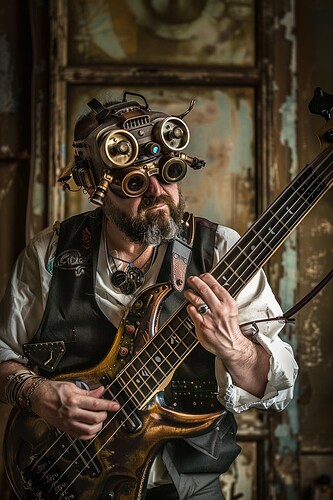Like so!?
Maybe not quite as extremely forward… ![]()
![]()

Edit: If I had Kate Middleton’sphotoshop skills, I’d had made that rapier a bass.
I would add that I think the problem is slightly worst with acoustics as the thickness of the body pushes it that little bit further away again.
One thing to do is to learn to focus on the side dots. They work both ways
I bought a playstation guitar game several years ago. It came with some little number decals that you could put on the side of the neck to help you.
You could number your frets that way until you can do it by muscle memory.
I had to do some experimentation for this:
When sitting, the fret ends are easy to see but I lean the base over a little so I can (just) see all four strings. The bass neck is horizontal but rotated at about 30 degrees to the line through my shoulders, probably so its easier to see where I’m fretting.
Once the bass is on a strap, the position it falls into is completely different. As per Josh’s instructions I have the bass just above hip level, and when the neck is lifted to about 30 degrees above horizontal, the fretboard comes into view again, so I end up with about the same view.
On a four string bass, my fretting fingers seems to know where they are going without too much ‘searching’ for the next fret. However, 18 months ago I made a 5 string bass and I found myself ‘lost’ at the fretboard for a couple of weeks. This year I thought a 6 string would be fun, so I restarted B2B and had a crack at Josh’s Beast exercise on a 6 string. I suspect the muscle training and regular practice are what really helps.
I wear mine high enough that I can still sit and it doesn’t remove the weight from the strap. It may not be cool but if it’s good enough for Victor Wooten, it’s good enough for me ![]()
Yarrr!

Wow, I’ve played standing so long I have no idea what to suggest other than to learn to do it without having to see the fretboard. When someone is gigging or jamming with others they’re usually not looking at their fretboard or expected to. Learn it from feel and from the side dots I guess.
![]()
![]()
I think strap length too long causes the top of the bass to tilt in towards the player when seated. If you shorten the strap the bass doesn’t tilt and you use the dots on the edge to find frets instead of looking at the fretboard more directly
Isn’t this what the dots along the side of the fretboard are for?
I don’t have a ‘protruding’ belly to angle the bass out and I wear the bass at around the height recommended by @JoshFossgreen, but I don’t have a problem knowing where I am on the fretboard. I have a problem, knowing where my fingers should be, but that’s an entirely different problem ![]()
BTW, I switch between basses. One of them, a Steinberger, hangs about 10cm to the leftof my Dingwall, meaning that the fretboard is displaced by c. 10cm. It’s a function of where the upper strap button is - fret 12 on the Dingwall and fret 21 on the Steinberger. The side dots are invaluable in that situation as the playing position is quite different.
I suspect the problem is that when we don’t have any experience with a guitar neck we are still looking to see where we’re fingering. I had a breakthrough part way through the course when I could suddenly play without looking at the neck at all (some songs, at least). When we’re sat it’s much easier to angle the guitar upwards and lean forwards ourselves without noticing we’re doing it so much. Standing suddenly adds a different angle and we’re not used to it. I would guess that 90% of us noobs start playing sat down.
Oh, and a big belly does not help the situation one tiny little bit. Hollowing out the wood from the back of the bass may be an option ![]()
As a relative newbie, I obviously couldn’t find my way around the fretboard without looking to start with, and equally obviously 9 months on that’s becoming much less of an issue. Mainly now just when working on something new/difficult or when there are significant position changes. Related to that last is the (so far) only walking base line I play and that travels up and down the length of the neck so much I really do have to watch my fingers!
I think many people have nailed the diagnostics here but would like to reinforce that fretboard staring is a newbie phase.
Once said person is more comfortable with the dots and fret positions it’s really just about memorizing string crossing and you phase out of the need to look at the fretboard in the most common positions.
Being able to see every note sitting is likely bad posture, so standing is just fixing that ![]() But if they need to see notes standing just tilt bass against your body?
But if they need to see notes standing just tilt bass against your body?
Funnily enough, Spector did just that. Actually, a Ned Steinberger design (yes, he of Steinberger), the back of the bass is contoured.
Ibanez EHB basses have an angle on the back of the bass that does just that.
I am starting to play left handed to over come an injury and keep playing bass, and I stand up and use the side dots because I really need the reference until muscle memory kicks in. Never used to stand, but I find it easier to get in good habits for positioning the hand, thumb, etc. standing. I would recommend this to new players, stand at the start.



